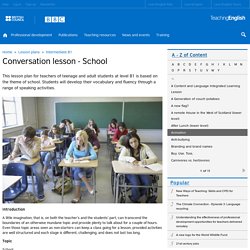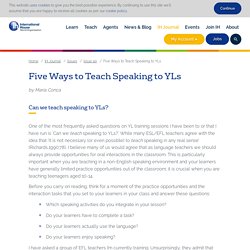

Designing and Using Information Gap Activities. Teacher's Corner: Speaking - Information Gap Activities. 7 Fun Information Gap Activities for the ESL Classroom. Speaking is a lot like investigating, isn’t it?

We use language to convey ideas and information. We also use it to ask questions, gather details and solve problems. Every time we speak we are acting as amateur detectives, striving to find out what we need to know about different situations on a daily basis. Teach your ESL students to be expert detectives, and they’ll also become expert English speakers! Teaching Speaking in an ESL Classroom. Create a Podcast >> Start Podcasting. Conversation lesson - School. Introduction A little imagination, that is, on both the teacher’s and the students’ part, can transcend the boundaries of an otherwise mundane topic and provide plenty to talk about for a couple of hours.

Even those topic areas seen as non-starters can keep a class going for a lesson, provided activities are well structured and each stage is different, challenging, and does not last too long. Topic School. 5 Techniques for Teaching Conversational English for the Real World. Teaching conversational English may seem like an easy endeavor. You simply give your ESL students a topic and let them talk, right? Oh, if only it were as easy as cutting them loose to talk about anything under the sun.
But chaos may ensue if this laissez-faire strategy is employed in your classroom. Teaching conversational English has many components, and it may call upon all your ESL teaching skills. This makes having a few effective conversational English teaching tips in your pocket vital—for your students’ growth and your “teacher of the year” class nomination. Conversation in Action Lets Talk by Edward R. Rosset (z lib.org) Lets Talk About It 1000 Questions for Conversation by Drayton Craig, Gibbon Mark. (z lib.org)
A Conversation Book 2 English in Everyday Life by Tina Kasloff Carver, Sandra Douglas Fotinos (z lib.org) Compelling Conversations Questions and Quotations on Timeless Topics An Engaging ESL Textbook for Advanced Students by Eric H. Roth, Toni Aberson (z lib.org) Teaching the Core Skills of Listening and Speaking by Erik Palmer (z lib.org) How To Teach Speaking (HOW) by Scott Thornbury (z lib.org) Five Ways to Teach Speaking to YLs. By Maria Conca Can we teach speaking to YLs?

One of the most frequently asked questions on YL training sessions I have been to or that I have run is ‘Can we teach speaking to YLs?’. While many ESL/EFL teachers agree with the idea that ‘it is not necessary (or even possible) to teach speaking in any real sense’ (Richards,1990:78), I believe many of us would agree that as language teachers we should always provide opportunities for oral interactions in the classroom. Teaching Speaking – Tips to develop the speaking skills of your students. Speaking is a fundamental language skill.

It is the primary way in which we communicate information. When we ask how well we can function in a second language, we ask the question “how well do you speak…?” British Council - Teaching Speaking Techniques (John Kay) Teaching speaking skills 1. While it is a bit of an exaggeration, students clearly feel that classroom-based speaking practice does not prepare them for the real world. Why do students so often highlight listening and speaking as their biggest problems? Partly because of the demands of listening and speaking and partly because of the way speaking is often taught. It usually consists of language practice activities (discussions, information-gap activities etc.) or is used to practise a specific grammar point.
TeachingEnglish. Online voice recorder. 936 FREE Speaking Worksheets. Learning to speak a new language is definitely a challenge.

It’s very difficult for your students to do if they don’t practice on a regular basis. Luckily, you need to look no further because BusyTeacher.org has the tools to help your students practice their speaking - and want to do it, too! Let’s face it, students aren’t always jumping for joy at the opportunity to speak a language they aren’t 100 percent comfortable with. Students can be hesitant to speak for a wide variety of reasons - fear of mistakes, peer pressure, or lack of self-confidence are some of the main factors.